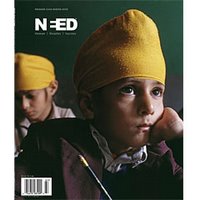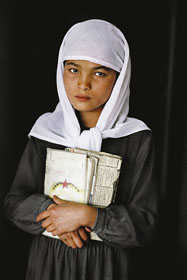 Flip through the premiere issue of NEED, a new magazine produced in northeast Minneapolis, and you'll be confronted: with horrifying before-and-after photos of Marthaline, a Liberian woman, whose tumor growing in her mouth the past three years was beginning to suffocate her, prompting her to buy poison to end her suffering. With a quote by a Minnesotan named Patrick who "got lost" looking for a bathroom while passing through New Orleans four months ago and ended up staying there to help rebuild the city. With the faces of young girls--their eyes blurred out to protect their identity--who'd been rescued from the sex trade in Cambodia, bursting into laughter over cans of Sprite.
Flip through the premiere issue of NEED, a new magazine produced in northeast Minneapolis, and you'll be confronted: with horrifying before-and-after photos of Marthaline, a Liberian woman, whose tumor growing in her mouth the past three years was beginning to suffocate her, prompting her to buy poison to end her suffering. With a quote by a Minnesotan named Patrick who "got lost" looking for a bathroom while passing through New Orleans four months ago and ended up staying there to help rebuild the city. With the faces of young girls--their eyes blurred out to protect their identity--who'd been rescued from the sex trade in Cambodia, bursting into laughter over cans of Sprite.But the confrontation isn't about guilt or shock, but hope: you can't help but be moved by how much people are pitching in to help those in need--and how little it takes to remove a benign tumor, pick up a hammer, or provide supplies for groups giving girls hope after being sold into sexual slavery.
The brainchild of Kelly and Stephanie Kinnunen, NEED launches today with a print run of 25,000 copies and the simple mission of giving exposure to humanitarian aid organizations that do good work. Beautifully designed and printed, perfect-bound, and filled with full-bleed photographs by photojournalists including Steve McCurry, the publication avoids the political, instead putting its energy toward connecting potential donors and volunteers for humanitarian causes with the beneficiaries of that work.
 The inaugural issue begins with an introduction to Timon Bondo, a 70-year old Kenyan man who lives in Golden Valley and has almost single-handedly raised funds to build two schools and a healthcare center in his AIDS-ravaged village Rabondo. His successes have come mainly through cold-calling--and despite one major obstacle: he's blind. But Stephanie Kunninen says NEED didn't feature Bondo's work simply to raise awareness of Rabondo or Bondo's work, but to also highlight how the man sets about helping his village.
The inaugural issue begins with an introduction to Timon Bondo, a 70-year old Kenyan man who lives in Golden Valley and has almost single-handedly raised funds to build two schools and a healthcare center in his AIDS-ravaged village Rabondo. His successes have come mainly through cold-calling--and despite one major obstacle: he's blind. But Stephanie Kunninen says NEED didn't feature Bondo's work simply to raise awareness of Rabondo or Bondo's work, but to also highlight how the man sets about helping his village."If you want to help a little girl with a school uniform, he won’t let you buy a school uniform. You buy fabric; then he utilizes one of the local seamstresses and pays her to sew the uniform for the child," she says. "One widow is taking care of 12 of her grandchildren because her husband and children have died from AIDS. So she makes bricks in her front yard while the children go to school, then when Timon does a building project, he buys the bricks from her instead of from the wealthy businessman in Nairobi."
The issue also features an array of aid programs around the world, including literacy programs in Afghanistan (McCurry's ImagineAsia among them); the floating MercyShips hospital that removed Marthaline's tumor (and those of many others); and Right to Play, a group founded by Olympic speedskating gold medalist Joey Cheek that uses sports as a platform to teach kids around the world about healthy living. Issue 2 will look at child soldiers in northern Uganda, Colombia's population of "internally displaced people" (the country has the world's second largest population of IDPs), and Wings of Hope, to name a few.
 The magazine, which sent out its first 2,500 issues over the past weeks, is a hit with philanthropists and nonprofits, says Kinnunen. She reports that a big supporter of the UN's Refugee Committee, the UNHCR, ordered 100 subscriptions for friends and family, plus bought up 1,350 issues to send to the organization's top monthly donors. But the Kinnunens are surprised at the buzz beyond this insider community.
The magazine, which sent out its first 2,500 issues over the past weeks, is a hit with philanthropists and nonprofits, says Kinnunen. She reports that a big supporter of the UN's Refugee Committee, the UNHCR, ordered 100 subscriptions for friends and family, plus bought up 1,350 issues to send to the organization's top monthly donors. But the Kinnunens are surprised at the buzz beyond this insider community."We’ve received a subscription from an inmate at Moose Lake Prison, a 16-year old high school student in Prior Lake, Minnesota, an order of nuns in north Minneapolis, a woman in Virginia who owns a tattoo parlor," she says. "NEED's demographic has become all across the board. Even my mother’s friends are clamoring for this."
But the early success has also earned other key endorsements: President Jimmy Carter agreed to an interview in the debut issue, and an impressive array of celebrated photojournalists have signed on. More remarkable is that group's assessment.
"We hear over and over and over again from photographers, 'This is the new LIFE Magazine for our generation of photojournalists.' That’s such a huge compliment to us," she says. "How could we ever—I mean, we’re six people in a warehouse office in Northeast Minneapolis! To hear this could be the next LIFE magazine is such an honor and shock, almost."
We hear over and over and over again,
"This is the new LIFE Magazine
for our generation of photojournalists."
"This is the new LIFE Magazine
for our generation of photojournalists."
The magazine is also compared to another famous publication, one heralded for its edgy design and unflinching portrayal of graphic suffering in the world--Oliviero Toscani's COLORS. Kinnunen says wherever she and her husband have lived--most recently, they lived in Finland, where Kelly taught at a university and Stephanie taught business English--they sought out each issue of the publication. "We love the imagery of COLORS Kinnunen says wherever she and her husband have lived--most recently, they lived in Finland, where Kelly taught at a university and Stephanie taught business English--they sought out each issue of the publication. "We love the imagery of COLORS. We love the storytelling of colors, but again, we're inspired by contact. There's no way for us to become involved with the something. Thgat's the one thing we didn't like about COLORS."
 The production value of NEED, however, is on par with COLORS', using full-color photos, with text as backup, to tell its stories. And NEED's art-magazine price tag of $9 seems to reflect that quality. But the Kinnunen's, who funded the magazine entirely with their own savings and their now-maxed-out credit cards, believe the cause is worth the price tag. "We have a 19.5% ad ratio to content, when we’re full. So if we’re full of ads, there’s 19.5% and you’re getting the highest quality printing, photography, and uninterrupted stories for nine dollars—if that’s to value of you, you see $9 as quite inexpensive. If you see $9 as too expensive, we do have a great website where people can get involved," Kinnunen says.
The production value of NEED, however, is on par with COLORS', using full-color photos, with text as backup, to tell its stories. And NEED's art-magazine price tag of $9 seems to reflect that quality. But the Kinnunen's, who funded the magazine entirely with their own savings and their now-maxed-out credit cards, believe the cause is worth the price tag. "We have a 19.5% ad ratio to content, when we’re full. So if we’re full of ads, there’s 19.5% and you’re getting the highest quality printing, photography, and uninterrupted stories for nine dollars—if that’s to value of you, you see $9 as quite inexpensive. If you see $9 as too expensive, we do have a great website where people can get involved," Kinnunen says.But, more convincing is her argument of the need for such production values. On one hand, she and Kelly were inspired by the director of a refugee shelter Kelly volunteered for in Greece years ago; he refused a load of bread from a baker who "was trying to pass off day-old bread" on the shelter residents, retorting, "Just because these people are poor doesn’t mean they don’t deserve the very best."
"So often aid organizations have such small budgets, and they don’t want to sacrifice their budgets that are going to directly helping people in need to promoting their work and connecting potential supporters to their work," she adds. "We wanted to help in that way. How do we help the people who are helping the people on the ground and showing the people in need in a dignified way?"
Photos (top to bottom): Cover of NEED, an Afghani boy in school, by Steve McCurry; Timon Bondo by Justin Grierson; Afghani Girl by Steve McCurry; a volunteer with a homeowner in New Orleans, by Leslie Spurlock.
More on NEED: Read my interview with Kinnunen at Worldchanging, plus Brian Lambert's "Disaster Glam."
2 comments:
Wow. That's badass and right in our backyard. Thanks for giving this some luft.
Awesome. Great to see the design/media world being used for a good cause, and not just to make another beautiful car ad.
Post a Comment